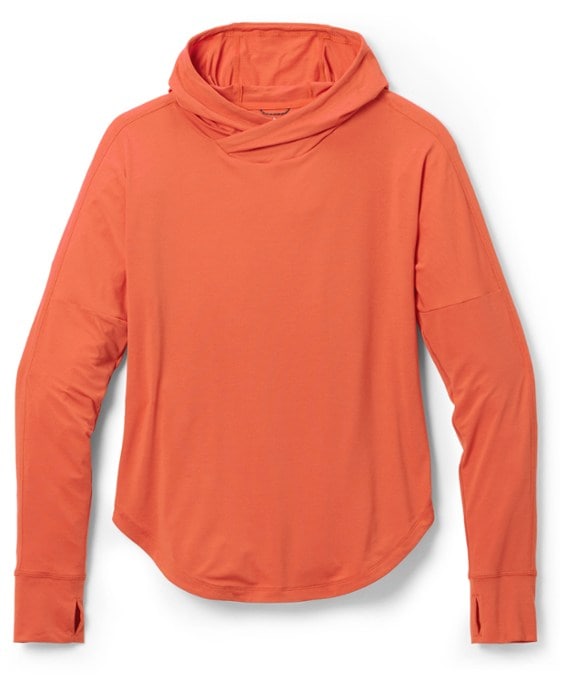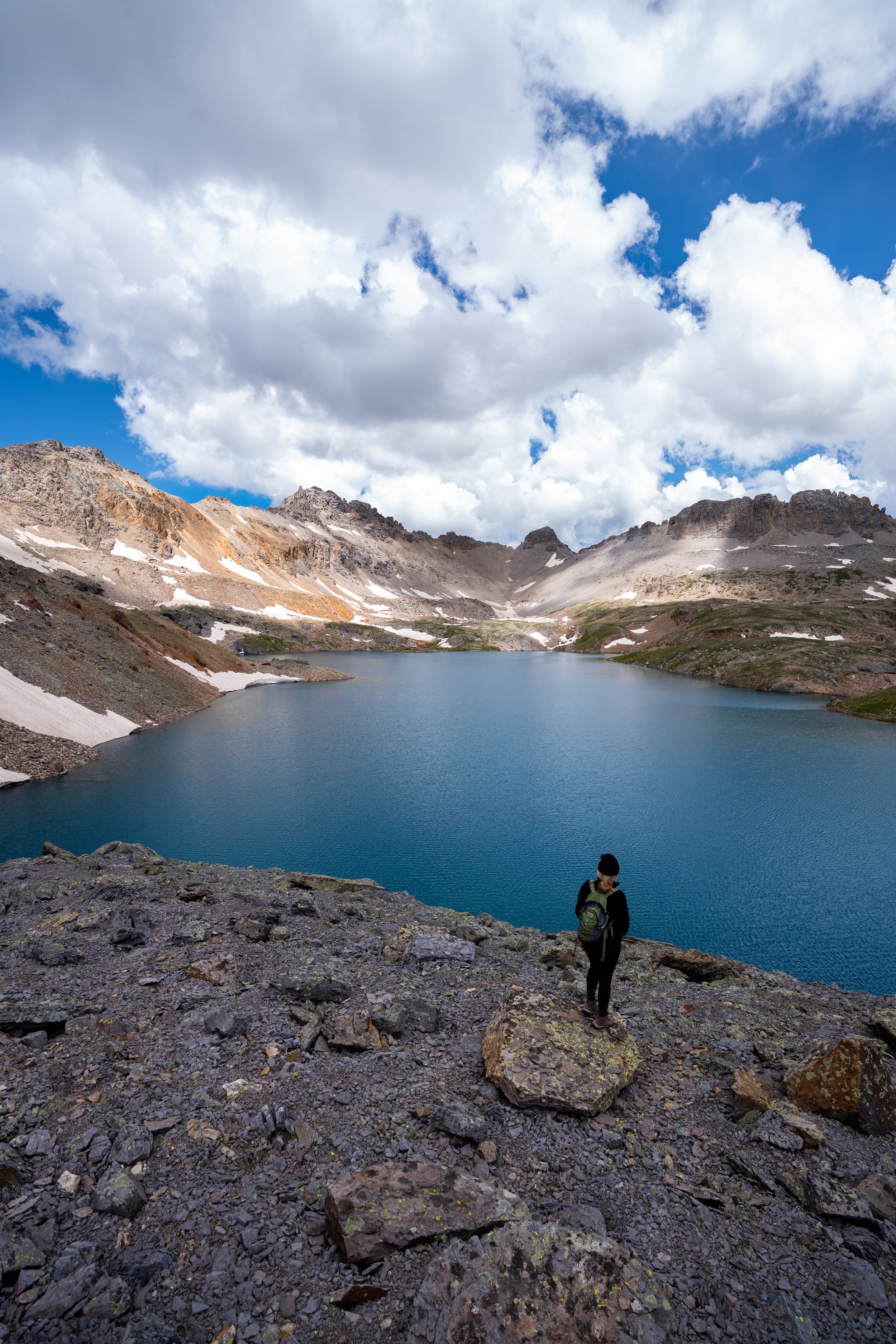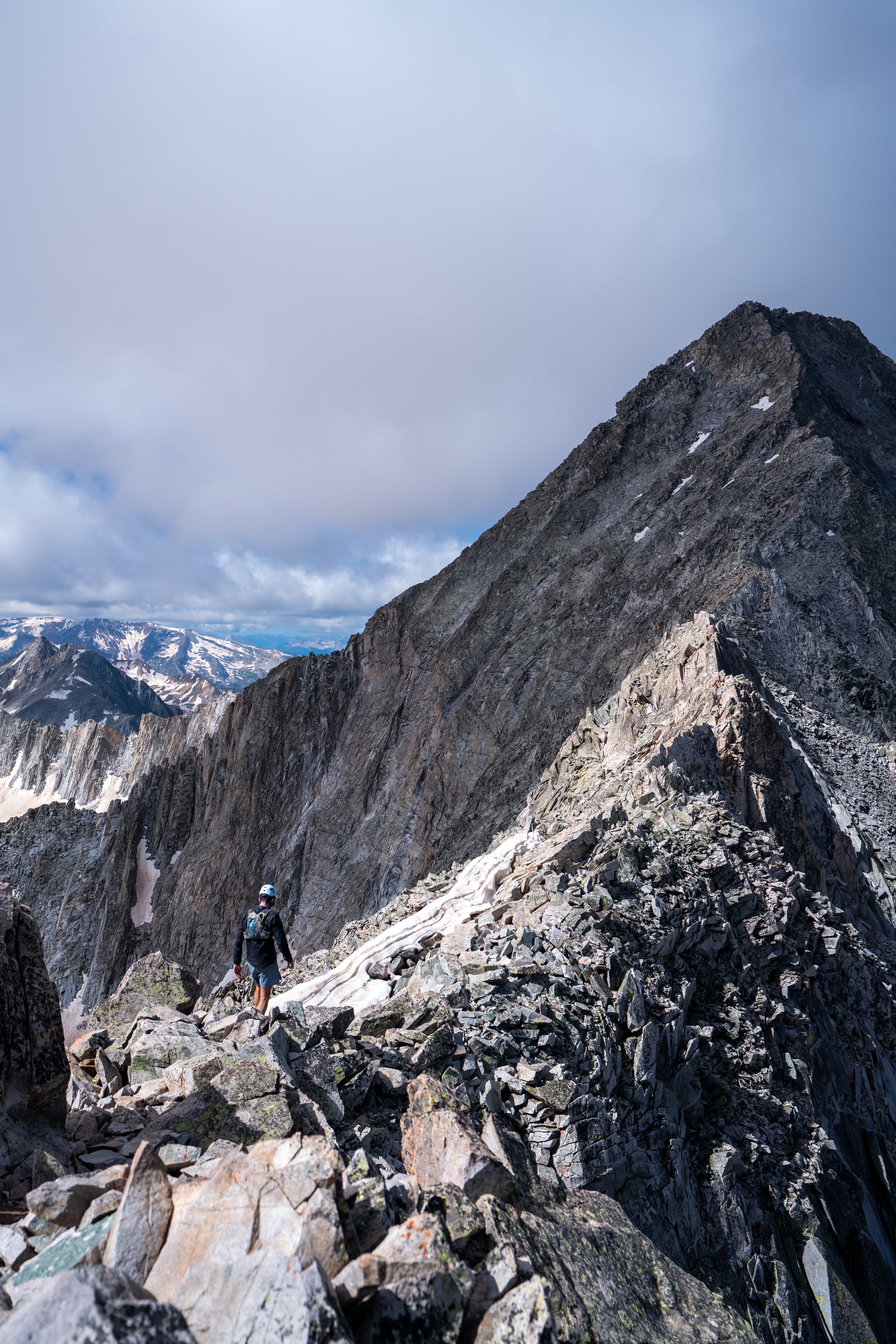Hiking the Ice & Island Lake Trail in Silverton, Colorado
Distance: 8.8 miles / 14.1 km
Elevation Gain: ~2,600 ft. / 792 m
The Ice Lake Trail, in the heart of the San Juan Mountains of southwestern Colorado, climbs to two of the most beautiful alpine lakes in all of the lower 48!
That being said, this steep 4.4-mile (7.1 km) trail is not for the faint of heart, as the Ice Lake Trail to both Ice and Island Lakes climbs constantly from the trailhead to the uppermost basin.
Therefore, out-of-state visitors may have difficulty with the upper elevations of the hike, which exceed 12,000 ft. (3,658 m) at both lakes in the upper basin.
On a different note, first-time hikers are often conflicted about whether to choose the Ice Lake Trail or the nearby Columbine Lake Trail—the sister hike located just a few miles north of Silverton, off the Million Dollar Highway—which is why I highly recommend reading my breakdown of these two amazing day hikes below.
Ice & Island Lake vs. Columbine Lake
I have been fortunate enough to hike both the Ice and Island Lake Trail, as well as the Columbine Lake Trail, numerous times to give you my honest thoughts about both. With that said, I personally enjoy the Columbine Lake Trail more than the Ice Lake Trail.
I say this because I feel that the hike, as well as Columbine Lake itself, is more beautiful than both Ice and Island Lakes. On top of this, the Columbine Lake Trail is nearly never as busy as the Ice Lake Trail, due in large part to the impacts of social media.
However, this goes without saying that the Columbine Lake Trail climbs about 300 ft. (91.4 m) higher than the Ice Lake Trail, meaning that some visitors may have difficulty reaching the 12,700-ft. (3,871 m) lake at the top of the hike.
All being said, this is just one person’s opinion, and recommending one trail over another is truly splitting hairs, as both the Ice Lake and Columbine Lake Trails are stunning, world-class adventures!
Read My Separate Post: Columbine Lake Trail
Ice & Island Lake Trailhead Parking
Parking for the Ice Lake Trailhead is located adjacent to the South Mineral Campground, roughly 4.4 miles (7.1 km) down the Forest Road 585 off the Million Dollar Highway.
In my experience, the Forest Road 585 should generally be passable for most 2WD vehicles, granted that the road is snow-free.
Google Maps Directions: Ice Lake Trailhead
Hiking Checklist - San Juan Mountains
Obviously, for camping, you will need general backpacking gear. For this reason, I wrote a separate post about what backpacking gear is worth the money, from my experience, and what the best alternatives are to save you money.
Read My Separate Post: Best Ultralight Backpacking Gear
In addition, here is a complete list of must-have things that you will want for any hike in the San Juan Mountains.
Bear Spray & Holster - If you aren’t flying, don’t rent bear spray! It’s a waste of money. Prepare ahead of time by buying your own, as this may be one of the most important items on this list.
Osprey 3L Water Bladder - The Osprey 3L water bladder is the most universal hiking and backpacking water bladder on the market, and it’s my go-to because of the slide-off seal that allows it to be quickly filled from the top. Additionally, individual parts are easily replaceable, such as the bite valve.
Black Diamond Headlamp - Personally, I recommend the Black Diamond Storm because it is one of the brightest, lightest, and longest-lasting headlamps on the market—and trust me, the weight-to-battery-life ratio really does matter!
Hiking / Trail Running Shoes - Depending on the type of trail, I prefer to use either the Keen Targhee for longer, more rugged hiking or the HOKA Zinal Trail-Running Shoe for lighter, less intense trails. In either case, both have been amazing to me for many years across countless environments, and both can be found in men’s and women’s sizes. - (Men’s Keen / Women’s Keen) (Men’s HOKA / Women’s HOKA)
Blister / Heel Protectors - I swear by these cheap, amazing heel protectors to prevent blisters for nearly every kind of hiking and backpacking that I do!
Waterproof Rain Shell - You never know when it may rain, and I’ve learned over the years that a rain shell is far better than a rain jacket. By this, I mean that it’s best to have something that the water will roll right off of, which is why I recommend the Patagonia Torrentshell 3L available in both men’s and women’s sizes.
High SPF Sunscreen - Packing high-SPF sunscreen is a must for long days outside!
Hiking the Ice Lake Trail
Beginning from the Ice Lake Trailhead just below 10,000 ft. (3,048 m), the Ice and Island Lake Trail gains about 2,700 ft. (823 m) to where most turn around at Island Lake, about 4.4 miles (7.1 km) ahead.
Almost immediately, the Ice Lake Trail begins climbing roughly 34 switchbacks from the trailhead to the Upper Ice Lake Basin.
However, this number may vary from person to person, depending on how you count.
Once at the first Clear Creek crossing, the sections heading uphill to the point where the trail passes by Clear Creek Falls are fairly visible, giving a good idea of the incline to come.
Ice Lake-Clear Lake Road Junction
At this split, go left to continue on the Ice Lake Trail up to the Lower Basin.
The trail to the right is nothing more than a short connector with Clear Lake Road, which can make for a nice alternative trailhead to cut out about 500 ft. (152 m) elevation gain up to this point.
Clear Creek Falls
This is Clear Creek Falls, located just to the right of the junction shown above.
After Clear Lake Road, the Ice Lake Trail begins its ascent to the Lower Ice Lake Basin, which can more easily be seen here as the low point of the incline in the photos below.
At roughly 1.6 miles (2.6 km), the Ice Lake Trail begins climbing another set of steep switchbacks up to the Lower Ice Lake Basin.
Here, some hikers may prefer to use poles—especially for the hike back down!
Lower Ice Lake Basin
After about 2.2 miles (3.5 km), the Ice Lake Trail reaches the Lower Ice Lake Basin, where the trail climbs above the tree line.
It is for the sections beginning here and higher that I recommend wearing a hooded sun shirt for the hike, which is especially useful when there are large snowfields in the San Juans during the early and later summer season.
Ice Lake-Island Lake Connector Junction
Shortly after reaching the Lower Ice Lake Basin, the Ice Lake Trail splits, with a short but steep connector that leads directly to Island Lake.
Some prefer to use this route on the return hike to bypass Ice Lake on the way down, but I personally think the steep connector is a tedious alternative to an already steep trail up to the Upper Ice Lake Basin.
In any case, go left to continue on the standard route up to Ice Lake.
Warning
Afternoon thunderstorms in high Mountain West areas, such as this, are a serious concern during the summer monsoon season.
Even if the weather forecast doesn’t predict any storms, I can tell you from personal experience that they may show up out of nowhere and can put you and your entire group in a very dangerous situation.
I say this to emphasize the importance of turning around at the first sign of lightning, thunder, or even heavy cloud buildup. However, if you ever get caught in a storm unsuspectingly, follow the steps linked below to reduce the risk of getting struck.
U.S. Forest Service: Lightning Safety Tips
As the Ice Lake Trail reaches the far end of the Lower Basin, the final incline up to Ice Lake should start to come into view.
This is where the Ice Lake Trail begins to climb above the Lower Ice Lake Basin to the Upper.
Some hikers may find these final steep sections to the Upper Basin above 12,000 ft. (3,658 m) to be among the most difficult of the entire hike.
This where the Upper Ice Lake Basin and the trail leading up to Island Lake begin to come into view.
For context, the trail above Ice Lake to Island Lake traverses the hillside below in the peak in the photo below.
Upper Ice Lake Basin
As the Ice Lake Trail begins to level off, the trail reaches the Upper Ice Lake Basin, with Ice Lake and the junction for Island Lake located shortly ahead.
Ice Lake-Island Lake Junction
This first split in the Upper Ice Lake Basin is where the trails to both Ice and Island Lake split from one another.
That being said, go left to reach Ice Lake, or right to reach Island Lake up the hill.
Ice Lake
Then, at about 3.7 miles (6.0 km), the stunning turquoise-blue waters of Ice Lake come into view, below a number of notable 13,000-ft. (3,962 m) summits, like Vermilion Peak.
For those interested, there is a small path around Ice Lake, but in my opinion, the lake is most beautiful on the east side, where the main trail comes up, considering that the distant peaks make for a great mountain backdrop in photos.
Island Lake Trail
Past Ice Lake, the Island Lake Trail continues across the outlet to the north, without the need to return to the junction shown previously.
Essentially, the Island Lake Trail is, more or less, a 0.6-mile (1.0 km) extension with another 200 ft. (61 m) of elevation gain on the same Ice Lake Trail.
This is where the split to Island Lake at the beginning of the basin meets the Island Lake Trail from Ice Lake.
Here, go left to continue uphill to Island Lake, located about 0.4 miles (0.6 km) away.
This first part is the steepest, but the incline up the Island Lake Trail gets easier in the sections to come.
Some might find this moderately-exposed section to be a bit more challenging than anything up to this point. However, there are a number of places to walk safely, provided that the trail is snow-free.
That being said, micro-spikes may be necessary during the early and late summer seasons to safely navigate sections like this and others.
Island Lake
Typically speaking, Island Lake, at about 4.4 miles (7.1 km) and 12,400 ft. (3,780 m), is the end of the hike for most people.
The trail does continue up and over Grant Pass to Ophir, or it can be looped back down to the Ice Lake Trail via the shortcut mentioned previously.
If you choose this option, the hike back down to the Lower Ice Lake Basin is only 1.0 mile (1.6 km) before joining back with the Ice Lake Trail from the beginning. However, micro-spikes would most certainly be necessary during times of the year when the San Juans are holding snow.
Additional Early Season Gear
Depending on the winter snowpack, trails in the San Juans can be covered in snow well into June, making some sections extremely dangerous when they are snowy and icy.
For this reason, micro-spikes may be necessary on the upper elevations of the Ice Lake Trail, especially if you plan on hiking late in the season, as these photos show.
I personally use the Yaktrax below.
More Nearby Adventures
If you’re interested in reading about some more amazing adventures nearby, check out my separate posts below!
Best Way to Find Places to Stay!
Wherever I travel, I love to start my search for places to stay on VRBO.
Even if I don’t end up booking through them, I think it’s one of the best ways to see what’s in the area!
Best Way to Book Rental Cars!
I travel quite a bit, and I know firsthand that finding a good rental car deal can be a challenge, but that’s why I recommend comparing all of your options with Discover Cars.
In short, Discover Cars is a well-known, reputable business that allows you to search for the best deal across companies, and they have the best full-refund cancellation policy I’ve ever seen, valid up to 72, or sometimes even 48, hours prior to your reservation!
Book Here: Discover Cars
Safety
Mountain Ranges across Colorado are home to both Black Bears and Mountain Lions.
While hiking in Black Bear territory usually presents less danger compared to Grizzlies, hiking with bear spray is never a bad idea. However, it’s really up to your own discretion and comfort level.
Aside from wildlife, Colorado, like any Mountain West state, is known for its violent afternoon thunderstorms, which are more typical in the warmer summer months than other times of the year.
That said, it’s important to check the local forecast before setting off on any adventure, as lightning strikes are not uncommon in and near mountain ranges across the West. I have personally been knocked to the ground by a strike that hit near me in the past, and I confidently say that it’s an experience you don’t want to live through. This is why I highly recommend checking Mountain Forecast for any high-elevation adventures you may be interested in—especially when climbing a summit.
Finally, know that micro-spikes may be necessary for an early or late season adventure, but micro-spikes are never supposed to be a substitute for conditions that require crampons.
Disclaimer
All information provided on this blog is for informational purposes only and is not intended to be a substitute for information or advice from qualified professionals or managing agencies.
Noah Lang Photography LLC makes no representations or warranties regarding the accuracy or completeness of the information provided here, and readers should use their own discretion, judgement, and seek professional advice where it is appropriate.
Furthermore, Noah Lang Photography LLC shall not be held responsible for any injuries, lost individuals, or legal issues arising from the use of information provided on this website, and if applicable, the above safety disclaimer should be referenced to provide a generic overview of the risks involved.
All said, the content on this blog is for the sole use of Noah Lang Photography LLC, and unauthorized use or reproduction of this content is strictly prohibited.
Disclosure
This post is not sponsored.
However, some of the links in this post are affiliate links, which means that I may earn a small commission if a purchase is made through one of those links. This commission comes at no additional cost to you, and I only recommend products that I personally use and believe will add value to my readers. Thank you for your support, which enables me to continue creating more!
To read the full privacy policy, click here.

About This Blog
Noah Lang Photography, also known as @noahawaii, is 100% reader-supported!
I do not accept guest articles or sponsored content of any kind on my blog, which is why, if you enjoy the outdoor and travel content I create, please consider buying me a coffee!
I appreciate your support, which helps me continue to keep this blog alive!



























